Add this eBook to your basket to receive access to all 687 records. Our indexes include entries for the spelling acton. In the period you have requested, we have the following 687 records (displaying 601 to 610): These sample scans are from the original record. You will get scans of the full pages or articles where the surname you searched for has been found. Your web browser may prevent the sample windows from opening; in this case please change your browser settings to allow pop-up windows from this site. Boys entering Manchester Grammar School
(1900)
This Biographical Register of Old Mancunians lists boys alphabetically by year of entering the school. A bare register of entrants existed from 1888 onwards but it was only since the Second World War that any kind of detailed record was kept of those who passed through the school. So, in every case in this printed register, full name is given, in bold, surname first (in capitals); date of birth, and years attending the school; but for the earlier years sometimes there is no more information - or, equally, after investigation among Old Mancunians and published sources, the editors may have been able to furnish a condensed biography. An asterisk indicates a holder of a Foundation Scholarship. In the later years a current address is also given, as of 1964 to 1965, when the book was prepared. | Sample scan, click to enlarge
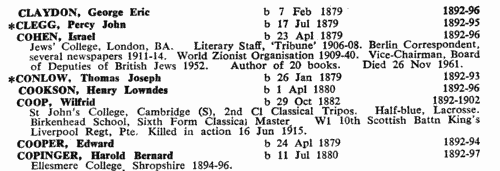
| Missing Next-of-Kin and Heirs-at-Law
(1900)
The Unclaimed Money Registry and Next-of-Kin Advertisement Office of F. H. Dougal & Co., on the Strand in London, published a comprehensive 'Index to Advertisements for Next of Kin, Heirs at Law, Legatees, &c., &c., who have been Advertised for to Claim Money and Property in Great Britain and all Parts of the World; also Annuitants, Shareholders, Intestates, Testators, Missing Friends, Creditors or their Representatives, Claimants, Unclaimed and Reclaimed Dividends and Stock, Citations, Administrations, Rewards for Certificates, Wills, Advertisements, &c., Claims, Unclaimed Balances, Packages, Addresses, Parish Clerks' Notices, Foreign Intestates, &c., &c.' The original list was compiled about 1880, but from materials dating back even into the 18th century: most of the references belong to 1850 to 1880. For each entry only a name is given, sometimes with a placename added in brackets: there may be a reference number, but there is no key by which the original advertisement may be traced. The enquirer of the time had to remit £1 for a 'Full and Authentic Copy of the Original Advertisement, together with name and date of newspaper in which the same appeared'. This appendix to the list was issued in about 1900. | Sample scan, click to enlarge

|  Outstanding soldiers of the British Army Staff Corps
(1881-1901) Outstanding soldiers of the British Army Staff Corps
(1881-1901)
Each year the best soldiers were chosen for long service and good conduct medals. This register gives rank, name, regimental number, and date of recommendation. (The sample scan is from the East Surrey regiment). The register is essentially a register of recommendations, annotated with details of the issue of the medals. Where no gratuity accompanied the medal, the entry is marked 'W. G.' (without gratuity); where, for one reason or another, the medal was not issued, the entry is marked 'N. S.' (not sanctioned) and struck through. | Sample scan, click to enlarge
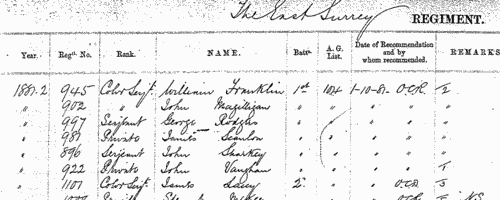
|  Outstanding soldiers of the Hampshire Regiment
(1881-1901) Outstanding soldiers of the Hampshire Regiment
(1881-1901)
Each year the best soldiers of the regiment were chosen for long service and good conduct medals. This register gives rank, name, regimental number, and date of recommendation. (The sample scan is from the East Surrey regiment). The register is essentially a register of recommendations, annotated with details of the issue of the medals. Where no gratuity accompanied the medal, the entry is marked 'W. G.' (without gratuity); where, for one reason or another, the medal was not issued, the entry is marked 'N. S.' (not sanctioned) and struck through. The regiment was based on the 37th Regimental District - Winchester. The 1st battalion returned from India 5 April 1875, set off again for India in 1884 and by 1885 was stationed on Malta and in 1895 is found at Ranikhot in Bengal. The 2nd battalion embarked for India 1 November 1872 and in 1885 was at Cannanore in Madras. Moving to Burmah in that year, the battalion took part in the surrender of Mandalay ("Burmah, 1885-1887"); it returned to India in 1887, and from India to England 7 February 1888. In 1894 it was transferred to Ireland, and by 1895 was stationed at the Curragh. In 1900 the troops were sent to South Africa, and fought at Paardeberg, the occupation of Bloemfontein, the advance on and the occupation of Johannesburg and Pretoria ("South Africa, 1900-1902", "Paardeberg"). | Sample scan, click to enlarge
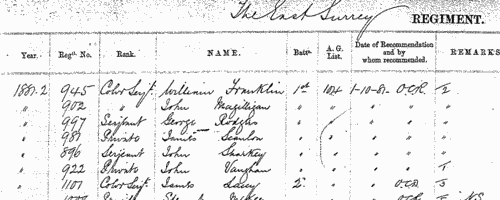
|  Outstanding soldiers of the Royal Welsh Fusiliers
(1881-1901) Outstanding soldiers of the Royal Welsh Fusiliers
(1881-1901)
Each year the best soldiers of the regiment were chosen for long service and good conduct medals. This register gives rank, name, regimental number, and date of recommendation. (The sample scan is from the East Surrey regiment). The register is essentially a register of recommendations, annotated with details of the issue of the medals. Where no gratuity accompanied the medal, the entry is marked 'W. G.' (without gratuity); where, for one reason or another, the medal was not issued, the entry is marked 'N. S.' (not sanctioned) and struck through. The regiment was based on the 23rd Regimental District - Wrexham. The 1st battalion embarked for Bengal in 1880, and by 1885 was stationed at Dum Dum; it was transferred to Burma for the campaign of 1885 to 1886 ("Burma, 1885-1887"), returning to India in 1887. The battalion took part in the Hazara Expedition of 1891. In 1895 it was at Jhansi. The troops returned to England via Aden in 1897, but were dispatched to South Africa in 1899, where they added "South Africa, 1899-1900" and "Relief of Ladysmith" to the regimental honours. The 2nd battalion returned to England from Gibraltar in 1880, was transferred to Ireland in 1883, and was at Templemore in 1885. The battalion returned to England in 1892, and was at Manchester in 1895. In 1896 the 2nd battalion was sent out to Malta, where it took part in the occupation of Crete; and on to Hong Kong in 1898, fighting in China and adding "Pekin, 1900" to the colours. | Sample scan, click to enlarge
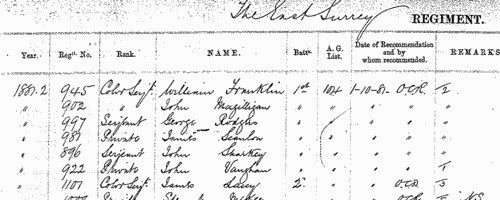
| Boys entering Clifton College
(1901)
Clifton College near Bristol was established in 1862. This edition of the Clifton College Annals and Register for the Old Cliftonian Society by F. Borwick was published in 1925. Boys are listed alphabetically by term of entry, with full names, surname first, in bold. Father's (or widowed mother's) name is given (surname and initials) in capitals, and address. Then there is the name of the house (N. T., North Town; S. H., School House; S. T., South Town), first and last forms, distinctions in school work and games, and month of leaving. Where known, the editor then gave a career summary with month of death; or, if still living, address as in 1925 (in italics). | Sample scan, click to enlarge
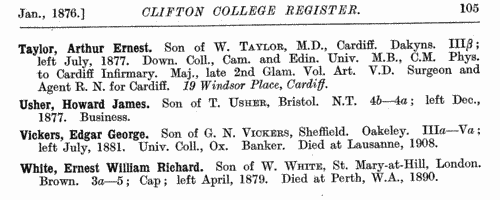
| Unclaimed Naval Prize Money
(1855-1902)
Various prize moneys were awarded to officers and men who served on board her Majesty's ships. For one reason or another a substantial number of these prizes, from as little as a shilling or two to as much as many pounds, remained undistributed by 1902, when this comprehensive list of the unclaimed moneys was printed: it lists unclaimed shares of prize money, slave and pirate bounties, salvage awards, parliamentary grants, gratuities and other moneys distributed by the Admiralty 1855 to 1902, but which omits moneys for service on the China Station during the war of 1856 to 1880, and special gratuities for service in Egypt (1882), Soudan (1884) and Soudan and Nile Expedition (1884-1885), for which there are separate indexes. In each case the sailor's name is given first (surname, then christian name or initials); rank or rating; ship in which serving at time of capture or award; and the amount due. | Sample scan, click to enlarge

|  London Metropolitan Police
(1892-1902) London Metropolitan Police
(1892-1902)
The London Metropolitan Police Register of Joiners (MEPO 4/336) lists policemen joining the force 1 January 1892 to 23 June 1902 (warrant numbers 77319 to 88811). The register is alphabetical, in so far as the recruits are listed chronologically grouped under first letter of surname. It gives Date of Appointment, Name, Number of Warrant, Cause of Removal from Force (resigned, dismissed, promoted or died), and Date of Removal. A final column of 'Remarks' is largely blank, but occasionally gives an alias or a cross-reference to another warrant number. | Sample scan, click to enlarge

|  British artillerymen fighting in South Africa
(1899-1902) British artillerymen fighting in South Africa
(1899-1902)
The Queen Victoria's South Africa Medal was awarded (after her death, in the event) to all who had served honourably in the various campaigns in the Boer War. Returns were made from each unit, and consolidated into nominal roll, of which this is the one for the Royal Artillery. Confusingly, the ledgers used had originally been printed for a register of men transferred (or re-transferred after mobilization) to 1st Class Army Reserve. All the original column headings were therefore struck through, and the roll was prepared with this information: Date of Issue; Regimental Number; Rank; Name; Unit; Medal (a 1 indicating that a medal was awarded); [number of] Clasps; the reference to the source in the original returns, usually starting with AG for papers in the hands of the Adjutant-General, and 68/Art/ for the Royal Artillery records. The final column, normally left blank, was occasionally used for explanatory remarks. | Sample scan, click to enlarge

| Associate Members of the Institution of Civil Engineers
(1904)
The Institution of Civil Engineers was established 2 January 1818, and incorporated by royal charter 3 June 1828. The annual report lists the names and addresses (throughout the world) of the four classes of member - members (M. Inst. C. E.), associate members (Assoc. M. Inst. C. E.), associates (Assoc. Inst. C. E.), students (Stud. Inst. C. E.) - with the dates of admission. This is the index to the Associate Members. The symbols at the left of each page are * for Former Students, + for contributors of papers published in the Minutes of Proceedings, or of an Engineering Conference Note; F for a deliverer of a James Forrest Lecture; L for a deliverer of one of the Special Series of Lectures; and various letters for recipients of certain medals and prizes - B, Bayliss Prize; C, Crampton Prize; f, James Forrest Medal; H, Howard Quinquennial Prize; J, Joule Medal; M, Miller Scholarship; m, Miller Prize; italic m, Manby Premium; S, George Stephenson Medal or Prize; T, Telford Premium; t, Telford Premium; italic t, Trevithick Premium; and W, Watt Medal. Those elected prior to 2 December 1878 had been transferred into this class by the Council. | Sample scan, click to enlarge
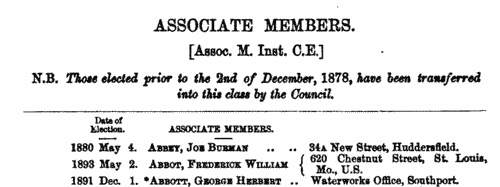
|
Research your ancestry, family history, genealogy and one-name study by direct access to original records and archives indexed by surname.
|












